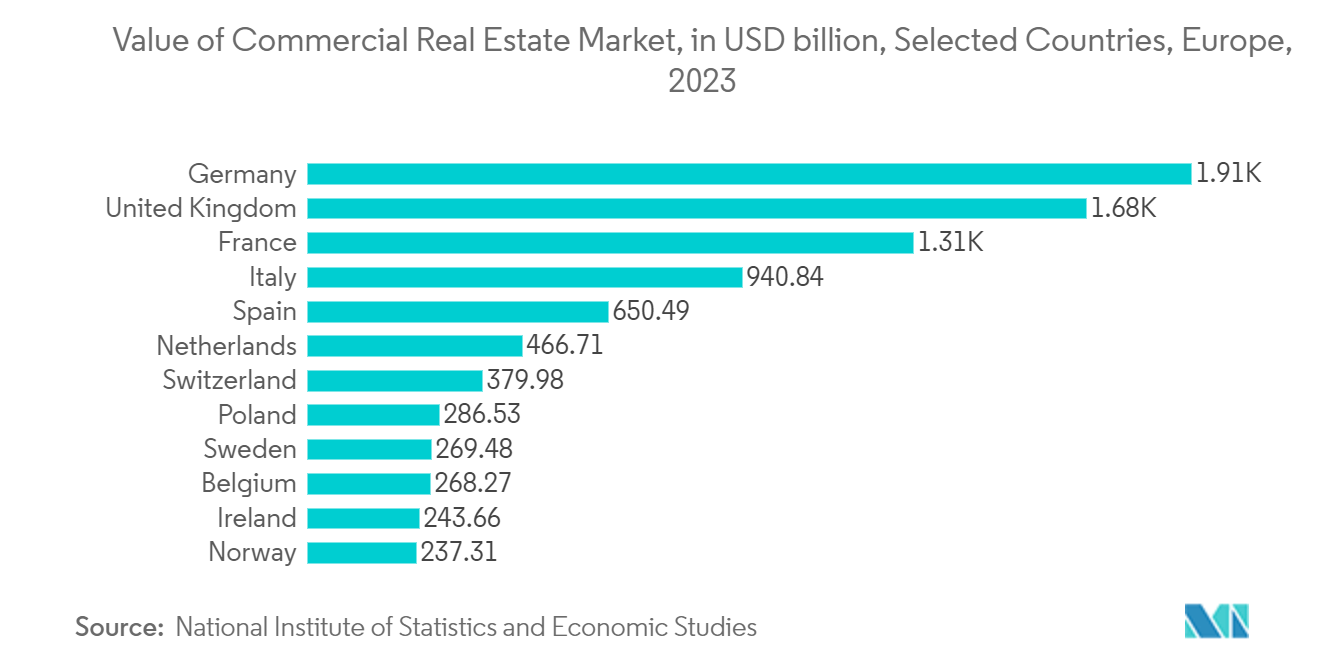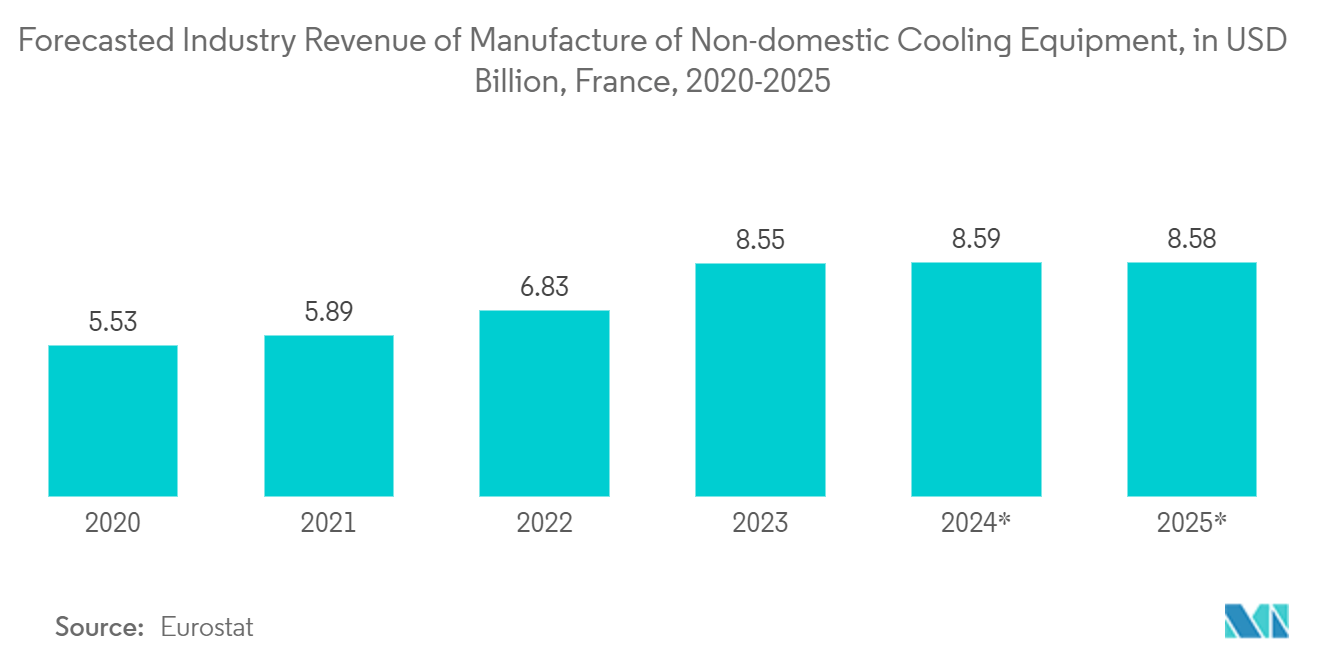Market Trends of Europe HVAC Industry
The Commercial Segment is to be the Fastest-growing End-user Verticals
- The commercial segment involves the use of applied HVAC equipment in commercial buildings and infrastructures, such as restaurants, residential lodges, and small to large shopping complexes and offices. In commercial buildings, semi-custom HVAC equipment is installed wherever the buildings are not uniform and require certain customizations instead of the standard equipment available in the market.
- Heat pumps are an ideal choice for commercial properties as they provide numerous advantages that go beyond conventional heating and cooling systems. Heat pumps excel in enhancing energy efficiency, minimizing operational expenses, and promoting environmental sustainability and decarbonization. By implementing heat pumps, commercial properties can effectively reduce their carbon footprint and actively contribute to sustainability efforts. Embracing these systems is a wise investment that not only improves efficiency and saves costs but also positions commercial properties as pioneers in the shift toward a cleaner and more sustainable energy future.
- Commercial heat pumps have a broad range of applications across different property types and serve various purposes. The growth of heat pumps in commercial settings is anticipated to be further boosted by government efforts. For example, the UK government is actively promoting the adoption of heat pump technology as an alternative to fossil fuel boilers in commercial settings. There are numerous programs accessible to assist UK companies in transitioning to heat pump systems.
- Several companies are constantly investing in introducing various products catering to the demand for these heating systems in the commercial segment. For instance, in November 2023, Daikin disclosed information regarding two upcoming VRV 5 heat pump systems that are scheduled to be released in the first half of 2024. These new systems, namely the Mini-VRV and the Top-Blow series, are designed to cater to the growing demand for decarbonization in commercial buildings. The Mini-VRV system will now offer expanded capacities of up to 33.5 kW, while the new Top-Blow series will reach an impressive 56 kW. With these additions, Daikin is further enhancing its product portfolio to support the transition toward more sustainable and energy-efficient solutions. Such vendor activities are expected to increase the market’s potential.
- The European commercial real estate market was valued at over USD 9 trillion in 2023, according to the European Public Real Estate Association, with Germany, the United Kingdom, and France together accounting for more than 50% of the total market. The commercial real estate market in Germany was valued at USD 1.9 trillion in 2023. Meanwhile, commercial real estate investments in Europe weakened in 2023 compared to 2022. The total commercial real estate investment volume was EUR 253 billion (USD 270.43 billion) in 2022, which dropped to about 133 billion in 2023. Such high investments in the commercial real estate sector should drive the commercial segment's growth in the HVAC equipment market.

France is Expected to Witness Significant Growth
- The market is expected to witness high growth as France wants to replace residential fuel and gas heaters with heat pumps and create an industry to make the device in a bid to reduce greenhouse gas emissions. The government plans to promote heat pumps as a way to heat houses as part of a multi-year environmental plan.
- The country has approximately 27 heat pump factories, and the government is focusing on increasing the production of heat pumps to meet the growing demand, further driving the market's growth. For instance, in April 2024, the French government announced that the country must produce one million heat pumps before the end of 2027. The plan unveiled by the government has two key elements. Firstly, the government will continue various schemes that help consumers purchase heat pumps, such as 'MaPrimeRénov' and energy-saving certificates.
- Secondly, the government will directly support manufacturers, building on Europe's new openness to support strategic green industries. The French program will support the construction of factories through tax incentives that can amount to up to EUR 200 million (USD 213.41 million) per factory in investment aid.
- According to EUROSTAT, residential construction accounted for 6.80% of France's GDP in December 2022. The Ministère de l'environnementne reports that in 2023, France had approximately 38 million registered dwelling units to accommodate a population of over 67 million. This figure was nearly 33 million in 2008. Additionally, France has consistently built no less than 300,000 new homes per year over the past two decades, with some years reaching approximately 500,000 new homes. As residential construction activities continue to increase, there will be a significant demand for efficient cooling solutions.
- As temperatures are rising worldwide, the demand for air conditioning in France is also increasing. According to EUROSTAT, the revenue from the manufacturing of non-domestic cooling and ventilation equipment in France is expected to be approximately USD 8.584 billion in 2025. Such an increase should support the HVAC market's growth.
- Several players in the market are expanding their presence in the country to increase their market share, supporting market growth. For instance, in April 2024, Mitsubishi Electric Hydronics & IT Cooling Systems SpA and Mitsubishi Electric Europe BV announced that they would acquire AIRCALO. Through this acquisition, the company expects to leverage AIRCALO's broad product line and strong customization capabilities to expand and upgrade its hydronic HVAC systems business in the diversifying European market.


